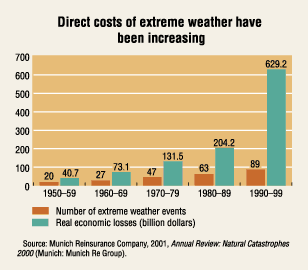 About F&D Subscribe Back Issues Write Us Copyright Information Free Email Notification Receive emails when we post new
items of interest to you. |
Adapting to Climate Change Peter S. Heller and Muthukumara Mani Not much talked about but still worrisome are the economic and fiscal disruptions likely to be caused by global climate change, especially for developing countries. Policymakers should take steps to minimize these disruptions, and sooner rather than later. After decades of debate, global warming is now recognized as inevitable, with its impact likely to be felt for centuries to come. Even the most conservative forecasts suggest that the Earth's climate is already warming at a pace that is without precedent over the last ten thousand years. Although there remains considerable uncertainty on the pace, magnitude, and regional distribution of the changes that can be anticipated over the next century, the need for policy actions to mitigate the sources of global warming is generally accepted (see box).
The focus thus far has been on what the industrial nations should do, given their responsibility for the present concentration of greenhouse gases. In the Kyoto Protocol, adopted in December 1997, the industrial nations agreed to limit emissions of these gases relative to the levels of 1990. The role of the developing countries in these mitigation efforts is still being debated, and the outcome of this debate will be critical, given the rapid growth of their greenhouse gas emissions. But far less attention has been paid to what developing countries should do to adapt to the consequences of climate change. This is particularly worrisome because climate change affects both poverty and development. Much of its impact is likely to be borne by the rural poor in the tropics and subtropics, whose capacity to cope is extremely limited. Even the smallest temperature increase in these areas would lower agricultural productivity. If this happens, malnutrition will become more prevalent and water will become scarcer in many areas—increasing the incidence of diseases that are vector borne (for example, malaria and dengue fever) and water borne (for example, cholera). Rising sea levels could displace tens of millions of people in low-lying river deltas in countries such as Bangladesh and India as well as in small island states, potentially disrupting the livelihoods of poor people by reducing the amounts of goods and services available from ecological systems, such as coral reefs, mangrove swamps, and forests. Given this stark prospect, what can developing countries—and their development partners—do to improve their capacities to cope with and adapt to climate change? Size of the problem Projections based on computer models suggest that instances of extreme weather—such as heavy and variable precipitation, heat waves, coastal storm surges, cyclones, and flooding—are likely to become more frequent and intense and to have a growing economic impact, much like an external economic shock (see chart). In 1998, weather-related economic losses in developing countries were about $42 billion, with a substantial share attributable to flooding in China along the Yangtze River and to Hurricane Mitch in Central America. In the latter case, the total damage to Nicaragua and Honduras was estimated to be at least two-thirds of each country's GDP.  The full economic costs of disasters, however, are probably even higher, because many indirect and secondary effects on economic activity—such as forced adjustments in monetary and fiscal policy and increased indebtedness—are left out of such calculations. In the , policymakers will need to cope with an increased risk of real shocks to their economies, which will affect their budgets and external positions and the welfare of the most vulnerable groups in their societies. Over the long term, they will need to cope with the effects of climate change on the underlying real production structures of their economies, with countries dependent on agriculture, livestock raising, and forestry most heavily hit. In principle, technologies already exist or could be developed to address many of the adverse social and economic effects implied by these longer-term trends. In industrial countries, the private sector will bear primary responsibility for carrying out most of these efforts (although it should be noted that some industrial countries in the Northern Hemisphere are expected to benefit, in net terms, from the effects of low to moderate warming over the next century). But in developing countries, governments will need to facilitate the private sector's efforts. The costs of doing so could have major consequences for fiscal policies and expenditure and tax policies. Adapting to the consequences What policy actions should policymakers take—keeping in mind that money spent on adapting to climate change may mean cutting back on investment that could lead to real income growth or a decrease in poverty? First, when crafting the fiscal stance, governments should take account of their countries' potential vulnerability to economic shocks arising from extreme weather events. Many developing countries will be increasingly exposed to the financial burdens of providing large-scale disaster relief and rehabilitation efforts, as well as revenue losses caused by sudden drops in production and incomes. In 1995, for example, extensive flooding in Vietnam resulted in sharp increases in food prices and inflationary pressures, which could not be wholly offset by external assistance. Developing countries cannot assume that international assistance will be sufficient for them to cope with all of the financial, fiscal, and real shocks of climate change. They should create a financial cushion, either by limiting overall debt or by creating contingency funds. Also, in many countries, the insurance sector is still young, lacking the ability to optimize its risk coverage and premium terms. Countries therefore need to develop domestic institutions and instruments to improve risk management. Second, governments should create the right incentives and institutions, provide more information to the private sector, and develop basic knowledge on adaptive technologies. Because the underlying productive bases of many economies will be hurt by climate change, efforts to stimulate real growth should begin before economic losses start to mount. Countries might want to
Third, governments should adopt fiscal measures aimed at providing concrete incentives for mitigation. Because of ill-chosen policies, the agriculture and water sectors in many countries are unnecessarily vulnerable to climate variability. If these countries could, through policy reforms (such as eliminating subsidies on water and energy use) and improved use of available technologies, become less vulnerable, they would almost certainly also reduce vulnerability to long-term, human-induced climate change. Carbon taxes to discourage the use of fossil fuels would appear inevitable, as developing countries will eventually need to mitigate the effects of climate change. As per capita incomes rise, new energy production facilities may replace obsolescent facilities. Economic incentives could be structured to encourage the use of new energy-saving technologies. Developing countries may also accrue fiscal benefits by participating in the Clean Development Mechanism, whereby an industrial country may, under the Kyoto Protocol, transfer technologies and investments to a host developing country to reduce the former's own emissions below some established baseline level. Fourth, developing countries whose economies will be hurt by global mitigation efforts should craft macroeconomic policies to help them adapt. Recent analyses by the Intergovernmental Panel on Climate Change suggest that oil-exporting countries may be hurt by global efforts to reduce consumption and emissions of fossil fuels. Indeed, nonindustrial oil-exporting countries could experience a reduction in their GDPs of up to 0.2 percent with no emissions trading and less than 0.05 percent with full emissions trading, and a projected drop in oil revenues of up to 25 percent with no emissions trading and 13 percent with full emissions trading, by 2010. Countries have moved to adapt to the expected deterioration in their terms of trade; they should also begin to adapt their fiscal positions and incentives in the real sectors of their economies. A first step would be to cut energy subsidies and increase tax revenues derived from fossil-fuel products. Of course, developing countries are not alone in these efforts. They are being helped by a number of international agencies—including the United Nations Environment Program, the Global Environment Facility, and the World Bank. The expansion of official development assistance to meet the industrial countries' target of 0.7 percent of GDP should include funds for helping developing countries adapt to climate change and financing research on energy-saving technologies and best practices in agriculture and other sectors. The international community should also strengthen its ability to deliver short-term relief as well as provide know-how on preventing or limiting the adverse consequences of climate change. The fiscal and macroeconomic issues need to be tackled as part of the IMF's annual health checks of member countries and, increasingly, as part of discussions on poverty reduction strategies. In addition, countries coping with balance of payments deficits created or swollen by natural catastrophes are likely to seek emergency IMF assistance. Whatever role they play in global mitigation efforts, many developing countries will have no choice but to adapt to the anticipated adverse effects of climate change. They will need to ensure that their legal and economic structures and price signals encourage the private sector to take adaptive measures. They will also need to take account of increased macroeconomic vulnerability and adjust current development paths to substantially decrease future costs. The international donor community can support these efforts by tackling market failures in the production of global public goods, stimulating the development of new technologies, and helping to finance relief and adaptation efforts. Failure to do so could undercut the global community's goal of cutting poverty in half worldwide by 2015. Suggestions for further reading: P. Freeman, 2000, "Infrastructure, Natural Disasters, and Poverty," in Managing Disaster Risk in Emerging Economies, ed. by Alcira Kreimer and Margaret Arnold, Disaster Risk Management Series, No. 2 (Washington: World Bank). Intergovernmental Panel on Climate Change (IPCC), 2001, Third Annual Assessment Report, Adaptation and Vulnerability (Cambridge, England: Cambridge University Press). Munich Reinsurance Company, 2001, Annual Review: Natural Catastrophes 2000 (Munich: Munich Re Group). National Research Council, Committee on the Science of Climate Change, 2001, Climate Change Science: An Analysis of Some Key Questions (Washington: National Academy Press).
|